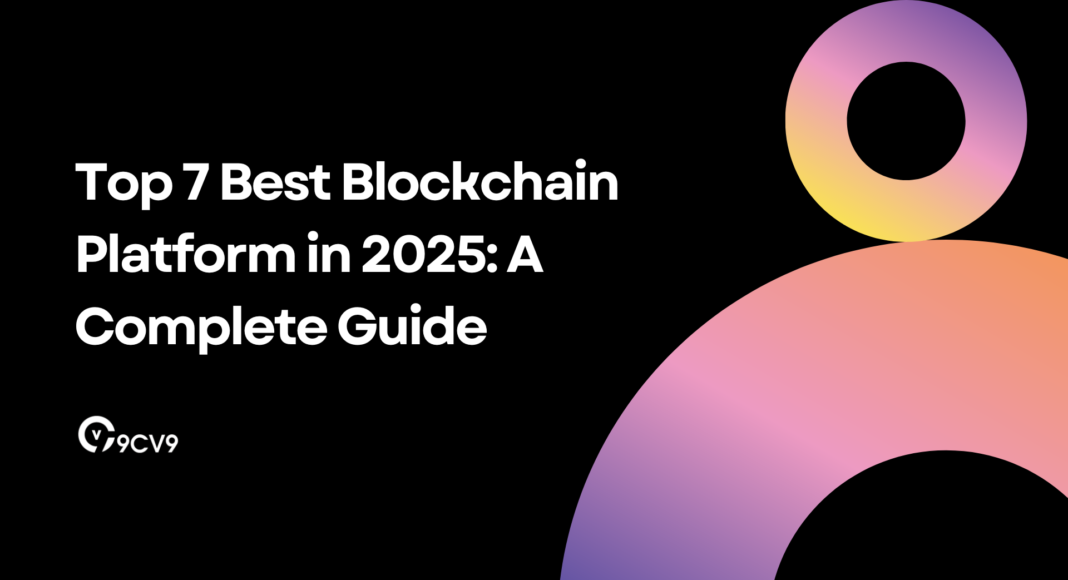Key Takeaways
- Discover the top blockchain platforms of 2025 offering unmatched scalability, security, and performance for diverse industries.
- Learn about advanced consensus mechanisms and features like smart contracts, tokenization, and seamless cross-border payments.
- Explore how these platforms are revolutionizing sectors such as finance, healthcare, and supply chain with innovative solutions.
Blockchain technology continues to revolutionize industries, offering unparalleled transparency, security, and efficiency in data and transaction management.
As businesses and developers increasingly integrate blockchain into their operations, choosing the right platform becomes a critical decision.
With an ever-evolving ecosystem, 2025 marks a pivotal year, showcasing blockchain platforms that cater to diverse use cases, from decentralized finance (DeFi) and supply chain management to gaming, non-fungible tokens (NFTs), and beyond.
The global blockchain market has grown exponentially, driven by advancements in scalability, interoperability, and accessibility.
According to recent statistics, the market is projected to reach $67.4 billion by 2026, highlighting the increasing reliance on this transformative technology. But with so many platforms available, how do you identify the best option for your specific needs?
In this comprehensive guide, we explore the top 7 blockchain platforms of 2025, meticulously selected based on their innovation, functionality, scalability, and market impact.
Whether you’re a developer aiming to build a decentralized application (DApp), an enterprise seeking to streamline operations, or an investor analyzing cutting-edge technologies, this article offers insights into what makes these platforms stand out in a competitive landscape.
We’ll delve into:
- Key features and functionalities that define each platform.
- Innovations in scalability and performance to handle increasing blockchain adoption.
- Industry-specific use cases, illustrating real-world applications.
- Developer-friendliness, including programming languages, tools, and support.
- Security and interoperability enhancements, ensuring robust and versatile blockchain solutions.
From established giants to emerging innovators, the blockchain platforms highlighted in this guide reflect the best in technology, reliability, and forward-thinking solutions. Join us as we unveil the most advanced platforms shaping the blockchain space in 2025 and how they can empower businesses, developers, and individuals to harness the potential of decentralized systems.
Before we venture further into this article, we would like to share who we are and what we do.
About 9cv9
9cv9 is a business tech startup based in Singapore and Asia, with a strong presence all over the world.
With over nine years of startup and business experience, and being highly involved in connecting with thousands of companies and startups, the 9cv9 team has listed some important learning points in this overview of Top 7 Best Blockchain Platform in 2025.
If your company needs recruitment and headhunting services to hire top-quality employees, you can use 9cv9 headhunting and recruitment services to hire top talents and candidates. Find out more here, or send over an email to [email protected].
Or just post 1 free job posting here at 9cv9 Hiring Portal in under 10 minutes.
Top 7 Best Blockchain Platforms in 2025: A Complete Guide
1. Ethereum

Ethereum remains one of the most powerful and influential blockchain platforms in 2025, continuing to play a pivotal role in the growth and advancement of decentralized technology. Recognized as the blockchain platform of choice for innovative projects, Ethereum has set the standard in many areas, from decentralized applications (DApps) and non-fungible tokens (NFTs) to smart contracts and decentralized autonomous organizations (DAOs). Ethereum’s introduction of smart contract programmability has fundamentally altered the blockchain landscape, empowering developers to create self-executing contracts with built-in trust and automation, all without needing intermediaries.
One of the key reasons Ethereum is considered a leading blockchain platform is its comprehensive and adaptable ecosystem. Ethereum allows developers to build decentralized applications (DApps) that operate on a peer-to-peer network, ensuring that control is distributed and not reliant on a centralized authority. This decentralized nature is a cornerstone of its appeal, particularly in the face of growing concerns about data privacy and centralized control. The Ethereum Virtual Machine (EVM) acts as the platform’s core infrastructure, enabling developers to deploy smart contracts and interact with the blockchain through the use of Solidity, a widely-adopted programming language. Solidity makes Ethereum accessible to developers, providing them with the tools needed to create complex decentralized applications with a high degree of flexibility and security.
Moreover, Ethereum’s evolution over the years has ensured its relevance in an increasingly competitive blockchain market. The integration of Layer 2 scaling solutions addresses one of the platform’s original challenges—scalability. These solutions, such as Optimistic Rollups and zk-Rollups, enhance Ethereum’s ability to handle a growing number of transactions, making it more scalable and cost-effective. By significantly reducing transaction fees, Ethereum has cemented its position as a practical and efficient platform for developers and businesses alike.
Ethereum’s transition to Proof of Stake (PoS) with the highly anticipated “Merge” in 2022 marked a transformative shift toward energy efficiency. Unlike the previous Proof of Work (PoW) system, PoS reduces the carbon footprint of the platform, making Ethereum more sustainable and environmentally friendly. This is especially crucial in a time when sustainability and energy conservation are at the forefront of technological development. With PoS, Ethereum not only improves its operational efficiency but also sets a precedent for other blockchain networks looking to achieve energy-efficient consensus mechanisms.
Ethereum’s ability to create and manage NFTs has further contributed to its status as a top platform in 2025. The rise of digital art, collectibles, and tokenized assets can largely be attributed to Ethereum’s pioneering work in providing a secure and transparent environment for NFTs. Ethereum offers an extensive array of tools for minting, trading, and managing NFTs, making it the go-to platform for creators and businesses seeking to capitalize on the booming NFT market.
At its core, Ethereum remains a versatile platform that supports a range of applications, such as Decentralized Autonomous Organizations (DAOs). DAOs allow for collective governance, enabling participants to make decisions democratically, without relying on a central authority. This ability to create decentralized organizations has been fundamental in reshaping industries, including finance, governance, and content creation.
Key Features That Make Ethereum Stand Out in 2025:
- Decentralization: Ethereum operates without a central governing authority, promoting fairness and eliminating the risk of a single point of failure.
- Security: Ethereum’s robust cryptographic security features protect against fraud, hacking, and unauthorized manipulation.
- Smart Contract Compatibility: The platform’s foundation in smart contract functionality allows for diverse and customizable decentralized applications (DApps).
- Ethereum Virtual Machine (EVM): As the underlying architecture of Ethereum, the EVM enables smooth execution of smart contracts and interactions within the network.
- Layer 2 Solutions: Ethereum incorporates Layer 2 scaling solutions that optimize scalability, reduce transaction fees, and improve the overall user experience.
- Proof of Stake Consensus: By adopting PoS, Ethereum ensures a more sustainable, eco-friendly approach to blockchain operations, contributing to a greener future.
- NFT and DeFi Support: Ethereum’s established ecosystem enables developers to create NFTs, DeFi platforms, and other blockchain-based solutions with ease.
Ethereum’s continuous innovation and adaptability make it a standout choice for developers, entrepreneurs, and organizations seeking to leverage blockchain technology in 2025. Its comprehensive features, secure infrastructure, and growing developer ecosystem ensure that Ethereum remains a leading platform in the ever-evolving blockchain landscape. For anyone looking to embark on blockchain development, Ethereum offers a rich, scalable, and sustainable platform with unmatched flexibility and potential.
2. Hyperledger Fabric

As blockchain technology continues to evolve, Hyperledger Fabric stands out as a premier platform tailored for enterprise-grade applications. Hosted by the prestigious Linux Foundation, Hyperledger Fabric is purpose-built to meet the needs of businesses and organizations seeking a robust, secure, and scalable solution for their blockchain initiatives. Unlike public blockchain platforms, Hyperledger Fabric specializes in creating private blockchain networks that emphasize speed, security, and privacy, making it one of the most trusted platforms in the blockchain space for business use cases.
Hyperledger Fabric offers an extensive ecosystem of modular components that can be customized and integrated into tailored solutions. This modularity is a key strength, allowing businesses to design their blockchain networks according to specific operational requirements. The platform supports various data models, such as account-based and unspent transaction output (UTXO) models, giving developers the flexibility to choose the architecture that best suits their application. This adaptability, combined with its focus on high-performance transactions, makes Hyperledger Fabric particularly well-suited for use cases in sectors like finance, supply chain management, and healthcare, where data privacy and low latency are crucial.
At its core, Hyperledger Fabric’s focus on privacy sets it apart from other blockchain platforms. The platform utilizes channels and private data collections to create isolated transaction environments, ensuring that sensitive business data remains confidential and that parties outside of the transaction cannot access or influence it. This commitment to privacy makes Hyperledger Fabric an excellent choice for businesses that require secure and private blockchain deployments, whether for financial records, intellectual property protection, or regulatory compliance.
In addition to privacy, Hyperledger Fabric’s performance is another compelling reason for its prominence in 2025. The platform boasts high-speed transactions with low latency, ensuring quick confirmation and finality of transactions. This performance is critical for businesses seeking to process large volumes of transactions swiftly and efficiently. Hyperledger Fabric also benefits from strong support from leading cloud providers such as Google, Amazon Web Services (AWS), and IBM, enhancing its accessibility and integration capabilities across a wide range of infrastructure environments.
Key Features that Elevate Hyperledger Fabric in 2025:
- Modular Architecture: Hyperledger Fabric’s customizable architecture enables businesses to tailor their blockchain networks to suit specific operational needs, ensuring both flexibility and scalability.
- Enterprise-Focused: Designed specifically for businesses, Hyperledger Fabric facilitates seamless integration with existing enterprise systems while ensuring regulatory compliance and operational efficiency.
- Data Privacy and Security: Through the use of channels and private data collections, Hyperledger Fabric offers secure, confidential transactions, making it an ideal choice for industries requiring high levels of privacy.
- High Performance: The platform provides low-latency, high-speed transactions, making it suitable for businesses that need to process large volumes of data in real-time.
- Support for Multiple Data Models: Hyperledger Fabric’s flexibility extends to its support for different data models, allowing businesses to choose the right structure for their blockchain solutions.
- Verified Identities and Permissioned Networks: Hyperledger Fabric ensures that all users within its network are verified and operates within permissioned environments, enhancing trust and security.
Hyperledger Fabric’s status as a top blockchain platform in 2025 is not merely due to its technological prowess but also its deep focus on meeting the unique demands of businesses. With its open-source nature, modular structure, and strong emphasis on privacy, security, and scalability, Hyperledger Fabric is shaping the future of enterprise blockchain applications. The platform’s enterprise-focused solutions provide businesses with the tools they need to implement innovative blockchain solutions while maintaining compliance and security. For businesses seeking a blockchain platform that blends performance, privacy, and flexibility, Hyperledger Fabric is undeniably one of the leading choices in the blockchain space in 2025.
3. IBM

IBM Blockchain, a pioneering Blockchain-as-a-Service (BaaS) solution, has solidified its position as one of the top blockchain platforms in 2025. Leveraging the powerful Hyperledger Fabric, an open-source and trusted framework, IBM Blockchain enables businesses to create, manage, and scale secure and reliable blockchain networks with ease. As an enterprise-focused platform, it simplifies the complex world of blockchain technology, making it accessible to companies across various industries. With IBM Blockchain, businesses can drive digital transformation, streamline operations, and enhance transparency while benefiting from fully managed blockchain solutions.
What sets IBM Blockchain apart is its user-friendly interface and robust suite of developer tools, making it easy for organizations to create and deploy blockchain networks regardless of their technological expertise. The platform supports the development of smart contracts in multiple programming languages, including Node.js, Java, and JavaScript, providing developers with the flexibility to work in the languages they are most comfortable with. This flexibility ensures that businesses can implement blockchain solutions tailored to their specific needs, without being restricted by the platform’s technological limitations.
IBM Blockchain also provides effortless deployment options with Ansible Playbooks or through the Red Hat Marketplace, streamlining the process of setting up and managing blockchain networks. With its intuitive console, users can manage multiple blockchain blocks and deployments, offering a level of simplicity and control that makes it ideal for businesses of all sizes. The platform’s ability to integrate with cloud services further enhances its scalability, ensuring businesses can easily expand their blockchain networks and resources as their needs grow.
In terms of reliability and uptime, IBM Blockchain ensures disaster recovery capabilities and consistently high availability, offering peace of mind to enterprises that depend on continuous, 24/7 operations. These features, coupled with the platform’s ability to seamlessly scale and its high-performance capabilities, make IBM Blockchain an invaluable tool for businesses looking to harness the power of blockchain technology to enhance their operational workflows and overall performance.
Key Features of IBM Blockchain:
- Developer Flexibility: Supports the creation of smart contracts in Node.js, Java, and JavaScript, giving developers the freedom to choose the most suitable programming language for their blockchain projects.
- Effortless Deployment: Streamlined network deployment through Ansible Playbooks and the Red Hat Marketplace, enabling businesses to quickly set up their blockchain infrastructure with minimal effort.
- User-Friendly Interface: An intuitive console that makes managing and monitoring multiple blockchain deployments easy, even for non-technical users.
- Cloud Integration: Seamless integration with cloud services for easy scalability and resource management, allowing businesses to expand their blockchain networks as needed.
- High Availability: Built-in disaster recovery and high uptime, ensuring that businesses can maintain continuous operations even in the event of unexpected disruptions.
Beyond its technical capabilities, IBM Blockchain provides enterprises with powerful business benefits. It optimizes multi-party workflows, ensures trusted and permissioned data, and accelerates value chain performance with blockchain applications. This makes it particularly valuable for industries with complex supply chains and multiple stakeholders, as it streamlines shared processes, increases accountability, and reduces disputes.
The platform also supports smart contracts, which can be used to facilitate product authenticity, build brand trust, and open new marketplaces through asset tokenization. This can help businesses tap into new revenue streams while ensuring the integrity of their products and services. IBM Blockchain can significantly enhance a company’s transparency and efficiency, leading to improved return on investment (ROI) and stronger relationships with customers and partners.
With its extensive suite of solutions and enterprise-ready features, IBM Blockchain is an ideal choice for organizations seeking to incorporate blockchain into their operations. The platform’s ability to simplify the development and governance of multi-institutional networks makes it especially beneficial for businesses in sectors such as finance, supply chain management, and healthcare, where collaboration between multiple stakeholders is key to success.
In conclusion, IBM Blockchain stands out as one of the top blockchain platforms in 2025 due to its flexibledevelopment environment, scalability, security, and ease of use. By offering fully managed blockchain solutions and a robust set of tools, it enables businesses to quickly and efficiently deploy blockchain networks that drive innovation and improve operational efficiency. For companies looking to embrace blockchain technology while minimizing complexity and risk, IBM Blockchain is a leading choice that combines enterprise-grade performance with simplicity and support.
4. Stellar

Stellar is rapidly emerging as one of the top blockchain platforms in 2025, particularly due to its ability to facilitate fast, low-cost cross-border payments. As an open-source and decentralized platform, Stellar aims to revolutionize the way financial transactions are conducted globally. By providing the necessary infrastructure to connect banks, payment processors, and individuals, Stellar plays a crucial role in streamlining international trade and financial services. Its Stellar Consensus Protocol (SCP) is a key component that ensures efficient, secure transactions with low fees and quick finality.
The platform’s focus on cross-border payments allows it to offer transactions that are completed in just 5 seconds, with minimal costs involved. Stellar’s ability to offer near-instantaneous transaction processing makes it a highly attractive solution for businesses and individuals engaged in global financial transfers, allowing them to bypass traditional banking systems and expensive intermediaries. The low transaction fees further strengthen its appeal, ensuring that users can transfer money across borders without incurring the typical high costs associated with conventional methods.
At its core, Stellar empowers developers to build secure, decentralized applications through its developer tools and SDKs. These tools provide the framework necessary for the creation of blockchain applications, enabling users to issue and trade digital assets such as currencies and commodities. Stellar also enables seamless integration with traditional banking systems, which is essential for establishing real-world financial connections. This integration allows businesses to facilitate efficient cross-border transactions, directly linking digital asset transactions to the global banking network.
Key Features of Stellar:
- Fast Transaction Processing: With the Stellar Consensus Protocol, Stellar ensures transactions are confirmed in 5 seconds, offering an unmatched level of speed and efficiency for financial operations.
- Low Transaction Fees: Stellar transactions incur minimal fees, which helps businesses and individuals save money while sending funds internationally.
- Cross-Border Payment Capability: Stellar connects banks, payment processors, and users, enabling smooth, cost-effective international transactions.
- Digital Asset Issuance: Users can issue, buy, and sell a range of digital assets, including currencies, commodities, and tokens, creating a flexible ecosystem for financial transactions.
- Integration with Traditional Banks: Stellar’s ability to integrate with real-world banking systems makes it a powerful tool for establishing secure financial connections, streamlining operations between digital and traditional financial institutions.
- Developer-Friendly SDKs: The availability of software development kits (SDKs) makes it easier for developers to build secure blockchain applications tailored to various industries and use cases.
Stellar’s Role in Financial Services and International Trade
Stellar’s influence extends beyond its role as a payment processing protocol. The platform has been adopted by leading companies in the financial services sector, including MoneyGram, Circle, and Flutterwave, for use in international trade and money exchange. These businesses leverage Stellar to offer faster and more affordable payment services to their customers. The platform’s widespread adoption in the financial industry further cements its position as a leader in the blockchain space, particularly for companies seeking to optimize cross-border transactions.
One of Stellar’s most groundbreaking features is its Soroban Smart Contract Platform, which allows developers to build Web 3.0 applications and decentralized finance (DeFi) solutions on the Stellar blockchain. This provides enterprises with powerful tools to integrate payment processing into their blockchain-based systems, helping them drive innovation while maintaining the security and efficiency Stellar is known for.
Stellar’s Key Advantages:
- Swift and Cost-Effective Transactions: The platform’s rapid processing time and low transaction costs make it ideal for businesses looking to optimize their international payments.
- Simplified Token Issuance: Stellar offers easy-to-use tools for issuing and managing tokens, which is essential for businesses and developers seeking to create digital assets for their operations.
- Promoting Financial Inclusion: With its focus on accessible infrastructure, Stellar is instrumental in facilitating financial inclusion, allowing individuals and businesses in underbanked regions to participate in the global economy.
- Regulatory Compliance: Stellar places a strong emphasis on compliance with regulatory standards, ensuring that its blockchain network remains in line with global financial regulations, making it a trusted solution for businesses and governments.
Why Stellar Stands Out in 2025
In conclusion, Stellar’s blockchain platform stands as one of the most innovative and efficient solutions for cross-border payments in 2025. The platform’s ability to facilitate quick, low-cost transactions, coupled with its strong focus on compliance and security, makes it an ideal choice for businesses and financial institutions looking to streamline their international payment processes. By connecting traditional financial networks with digital currencies and blockchain technology, Stellar has created a highly accessible and flexible financial infrastructure that offers a seamless, secure, and scalable solution for global payments.
For organizations engaged in international trade, payment processing, or financial services, Stellar provides the tools and capabilities needed to enhance operational efficiency, improve financial inclusion, and unlock new opportunities in the global market. As blockchain technology continues to evolve, Stellar’s role in the world of cross-border finance is set to grow, further solidifying its place as one of the top blockchain platforms in 2025.
5. EOSIO

Among the top blockchain platforms in 2025, EOSIO stands out due to its focus on scalability, flexibility, and high performance for the development of decentralized applications (DApps). As a free, open-source blockchain protocol, EOSIO provides programmers and business owners with a comprehensive suite of tools and resources to create, launch, and operate high-performance blockchain applications. Its versatility makes it an ideal solution for both private and public networks, supporting a broad range of use cases.
Built on a C++ framework, EOSIO’s architecture enables rapid transaction processing while offering robust customization options for developers. This makes the platform not only adaptable to various industries but also highly efficient and flexible in terms of creating applications comparable to traditional web applications. EOS, the native cryptocurrency of the platform, serves as both the token and a critical element of the EOSIO ecosystem, enabling seamless interaction within its decentralized network.
In addition to offering a secure environment for building blockchain-based applications, EOSIO comes equipped with a set of advanced features for authentication, permissioning, data hosting, and internet-to-DApp communication. These built-in tools allow developers to build scalable applications that can handle a diverse range of tasks, including smart contract execution and data trading, all while maintaining a seamless user experience. The platform is particularly noteworthy for its emphasis on decentralization, offering users the opportunity to engage with a peer-to-peer network without the need to incur transaction costs for operating decentralized applications.
Key Features of EOSIO:
- Scalable Architecture: EOSIO is specifically designed to handle high-throughput applications, supporting thousands of transactions per second (TPS), which makes it highly effective for businesses that require rapid transaction processing in real-time applications.
- User-Friendly Development Environment: The platform offers developers the tools and resources needed to create high-performance DApps, with a focus on simplicity and efficiency. Its C++ base enables flexibility in building applications that can scale to meet increasing demands.
- Low-Cost Transactions: EOSIO eliminates transaction fees, offering an attractive proposition for developersand end users by making it economical to operate decentralized applications without incurring high operational costs.
- Governance and Community Engagement: EOSIO introduces a governance mechanism, allowing stakeholders to vote on changes to the platform. This decentralized governance encourages community participation and ensures that the platform evolves in line with the needs of its users.
- Customizable Blockchain Implementations: With the tools provided by the EOSIO community, developers can customize blockchain implementations to suit a wide range of use cases in industries such as supply chain management, healthcare, and decentralized finance (DeFi).
Advantages of EOSIO:
- Delegated Proof-of-Stake (DPoS) Consensus: EOSIO uses the DPoS consensus mechanism, which ensures efficient and secure consensus while offering scalability. This method reduces the time and energy required for transaction validation, making the platform ideal for large-scale applications.
- Enhanced Transaction Speed: One of EOSIO’s most notable features is its ability to process transactions extremely quickly, which is essential for applications that require fast settlement times.
- Active Developer Community: EOSIO has cultivated a robust and engaged community of developers, which fosters collaboration and innovation within the ecosystem. Developers can leverage this community for support, discussions, and knowledge-sharing on blockchain technology.
- No Transaction Fees: EOSIO eliminates the need for users to pay transaction fees, which not only improves user experience but also makes it more accessible to a broader audience. This feeless environment encourages adoption and reduces operational costs for businesses.
Why EOSIO is a Top Blockchain Platform in 2025
In 2025, EOSIO continues to hold a prominent position as one of the top blockchain platforms due to its scalability, customizability, and focus on user-friendly development. The platform provides a robust environment for businesses and developers to create decentralized applications with ease, while also supporting high-throughput transactions. EOSIO’s emphasis on scalability makes it an ideal solution for industries requiring fast and efficient transaction processing, such as finance, supply chain, and healthcare.
The delegated proof-of-stake (DPoS) consensus mechanism, combined with rapid transaction times and low operational costs, allows EOSIO to offer a competitive edge over other platforms. With its open-source nature, EOSIO encourages innovation and collaboration within its ecosystem, driving advancements in decentralized technologies. As a result, EOSIO is well-positioned to continue leading the charge in blockchain development and deployment, making it an indispensable platform for businesses looking to leverage blockchain technology for decentralized applications in the coming years.
With its exceptional speed, scalability, and developer-friendly environment, EOSIO remains one of the most versatile and effective blockchain platforms available for businesses seeking to adopt blockchain technology for real-world use cases in 2025.
6. Ripple

Ripple has emerged as one of the top blockchain platforms in 2025, particularly in the financial sector, due to its ability to streamline and revolutionize global transactions. With RippleNet, the platform effectively connects banks, money transmitters, digital asset exchanges, and corporations, facilitating seamless, nearly-fee-less transactions on a global scale. Its native digital asset, XRP, has garnered significant attention and is currently the third-largest cryptocurrency, trailing only behind Bitcoin and Ether in terms of market capitalization. Ripple’s scalability and its ability to process payments faster than many other blockchain networks have made it a standout choice for businesses seeking efficiency in cross-border financial services.
Key Features of Ripple:
- Cross-Border Payments: Ripple’s core offering is its cross-border payment network, which enables global institutions to conduct payments without the need to pre-fund destination markets. This ensures that transactions are completed in real-time, with transparent tracking and on-demand settlement. Ripple’s low transaction costsand efficient payment processing make it an ideal solution for businesses involved in international trade and remittances.
- Ripple Liquidity Hub: One of the notable platforms within the Ripple ecosystem is the Ripple Liquidity Hub, which allows businesses to buy, sell, and hold digital assets seamlessly. Through this platform, companies can access aggregated liquidity pools, receive optimized pricing, and manage digital assets via a single API, streamlining operations in the digital economy.
- Central Bank Digital Currencies (CBDCs): Ripple has expanded its service offering by enabling the development of Central Bank Digital Currencies (CBDCs) and stablecoins. This solution, built on Ripple’s private ledger powered by XRP Ledger technology, facilitates the minting, management, and secure transaction of CBDCs and stablecoins, allowing central banks and financial institutions to leverage blockchain for digital currency solutions.
- Enterprise Blockchain Solutions: Ripple’s blockchain is designed with enterprise use cases in mind, allowing businesses to build tailored financial solutions or create international payment systems with ease. Ripple’s proven track record in the financial services industry makes it an essential tool for organizations looking to streamline their financial infrastructure and reduce costs associated with cross-border transactions.
Why Ripple is a Top Blockchain Platform in 2025:
Ripple continues to maintain its position as a dominant force in the blockchain space, particularly for financial institutions and enterprises looking to optimize their financial operations. With over 300 businesses globally already using Ripple’s technology to facilitate international payments, Ripple’s network is a testament to the growing trust and adoption of blockchain solutions within the financial sector.
The platform’s use of XRP as the native digital asset plays a pivotal role in enabling fast, cost-effective payment processing, while also providing financial institutions with a flexible liquidity management solution. Ripple’s scalability and low transaction costs provide it with a significant edge over traditional payment systems and other blockchain networks. Additionally, Ripple’s enterprise-level offerings, including liquidity hubs and CBDC solutions, enable businesses to diversify their revenue streams and explore new opportunities within the digital asset space.
Ripple’s ability to facilitate cross-border payments without the need to pre-fund destination accounts is a game-changer for global financial institutions, making it easier for businesses to expand their market reach and reduce the operational complexities typically associated with international payments. This unique selling point has positioned Ripple as a key player in the global payments network.
Additional Key Strengths of Ripple:
- Faster Payment Processing: Ripple’s consensus algorithm, based on probabilistic voting, ensures faster payment execution and higher scalability when compared to traditional payment systems and other blockchain platforms.
- Near-Zero Transaction Costs: By leveraging its innovative network, Ripple offers nearly free transactionswith zero chargebacks, providing cost-efficient solutions for businesses engaged in high-volume international transactions.
- Trusted by Leading Financial Institutions: Ripple’s technology is already being used by over 300 financial institutions worldwide, including major banks and payment providers. The platform has become a trusted partner in the financial industry due to its commitment to security, transparency, and reduced transaction costs.
Ripple’s Impact on the Financial Industry in 2025:
Ripple is not just another blockchain platform; it is a financial revolution that is reshaping how financial transactions are executed globally. By offering a range of innovative solutions, including cross-border payments, liquidity management, and central bank digital currency (CBDC) support, Ripple is providing financial institutions with the tools they need to stay ahead of the curve in the digital economy. Ripple’s growing influence and industry adoptionfurther cement its position as one of the top blockchain platforms in 2025.
With its rapid transaction processing, enterprise solutions, and growing ecosystem of businesses and financial institutions, Ripple remains a key enabler of the digital financial revolution. The cost savings, increased transaction speed, and global reach that Ripple offers make it an indispensable tool for companies seeking to optimize their financial services and tap into the potential of the blockchain in the coming years.
7. Tezos

Tezos stands out as one of the top blockchain platforms in 2025, thanks to its innovative technology and unique features that distinguish it from more established blockchain solutions. With a multi-layered software architectureand a strong emphasis on security, scalability, and upgradability, Tezos continues to push the boundaries of blockchain development. Over the years, Tezos has proven itself to be a reliable and cutting-edge blockchain platform that not only supports decentralized applications (dApps) and smart contracts but also excels in creating novel financial instruments such as non-fungible tokens (NFTs).
Key Features of Tezos:
- Decentralized Smart Contracts and Proof-of-Stake Consensus: Tezos integrates a robust smart contract platform that allows developers to deploy decentralized applications with ease. The Proof-of-Stake (PoS)consensus mechanism that Tezos employs is a significant step up from Bitcoin’s Proof-of-Work (PoW) and the initial Ethereum implementation. PoS is not only energy-efficient but also enhances network security and scalability, making Tezos a competitive option for both developers and enterprises looking for sustainable blockchain solutions.
- Self-Amending Blockchain: One of the most unique and advantageous aspects of Tezos is its ability to upgrade itself without requiring hard forks. This feature is implemented through a voting mechanism, allowing the community to propose and vote on changes to the protocol, including modifications to its consensus algorithm. As a result, Tezos can evolve organically over time without disrupting the network or forcing users to migrate to a new chain, ensuring stability and continuous growth.
- Formal Verification and Security: Tezos places a strong emphasis on formal techniques to increase the safetyand reliability of its smart contracts. This formal verification process allows developers to mathematically prove the correctness of their smart contracts, minimizing the risk of errors or vulnerabilities. As security continues to be a priority in blockchain development, Tezos offers a highly secure environment for developers and businesses to operate within.
- Dynamically Upgradable Protocol: Tezos supports a modular approach to software clients, enabling the platform to adapt to new uses and evolving technologies without major disruptions. Its dynamically upgradable protocol means that Tezos can quickly incorporate new features and optimizations without requiring a complete overhaul or a forking event. This allows the network to remain flexible and responsive to the ever-changing needs of the blockchain ecosystem.
- NFT and Enterprise Supply Chain Integration: Tezos has established itself as a platform that is not only suited for financial transactions but also ideal for NFTs and enterprise supply chain management. Tezos has been instrumental in automating the integration of NFTs into supply chains, offering new ways for businesses to track and manage assets. The platform’s scalability and efficiency ensure that it can handle high volumes of transactions, making it a preferred choice for enterprises interested in exploring blockchain-enabled innovations.
Tezos’ Continuous Evolution and Recent Upgrades:
Tezos has been undergoing rapid and continuous improvements, enhancing its capabilities and performance. Since its inception in 2014, Tezos has consistently refined its platform to meet the demands of developers, businesses, and consumers. The community-driven approach ensures that the platform is always evolving and adapting to industry needs and emerging technologies.
The Oxford 2 protocol, which went live in February 2024, brought several key updates to Tezos, making it even more powerful and versatile:
- Enhanced PoS Mechanism: The Oxford 2 protocol improves the PoS mechanism, further increasing network efficiency and scalability, addressing the growing demand for high-performance blockchain platforms.
- Timelocks and Improved Security: The new Timelocks transaction encryption provides additional layers of security, ensuring that transactions are conducted in a private and secure manner. This feature is especially critical as the demand for secure blockchain platforms in sectors like finance and healthcare continues to rise.
- Private Smart Rollups: Tezos now offers private smart rollups, which allow developers to choose between permissioned or permissionless deployments. This flexibility gives users more control over their privacy and data, catering to both public and private sector requirements.
Why Tezos is Among the Best Blockchain Platforms in 2025:
Tezos stands out in the crowded blockchain space due to its unique features, including its self-amending blockchain, strong security protocols, and efficient PoS consensus. Unlike many blockchain platforms that struggle with forkingor scalability issues, Tezos’s evolutionary approach allows it to maintain stability while incorporating community-driven updates. Its ability to dynamically upgrade without disrupting the network positions Tezos as one of the most adaptable and forward-thinking blockchain platforms available today.
Furthermore, Tezos’s focus on formal verification for smart contracts ensures that it remains one of the safest platforms for developers to work with. The integration of NFTs and enterprise solutions like supply chain tracking enhances its utility, positioning Tezos as a versatile platform that appeals to a broad range of industries. Whether it’s the ability to create decentralized finance applications, NFTs, or enterprise solutions, Tezos is continually evolving to meet the demands of the modern blockchain ecosystem.
With its cutting-edge upgrades, such as the Oxford 2 protocol, and a track record of consistent improvements, Tezos continues to demonstrate its value and relevance in the blockchain space, making it a key player among the top blockchain platforms in 2025. Tezos’s commitment to security, scalability, and self-upgrading protocols ensures its position as a leading choice for developers and businesses looking to build the future of decentralized applications and smart contracts.
Conclusion
As we move further into 2025, blockchain technology continues to evolve at a remarkable pace, driving innovation across various industries. The platforms highlighted in this guide represent the top choices for developers, businesses, and entrepreneurs who are seeking to leverage the power of blockchain to create decentralized applications (dApps), enhance transaction efficiency, and offer new solutions for financial services, supply chain management, and more. Each of these platforms has distinguished itself through its unique features, scalability, security, and community-driven development.
Ethereum remains a leading blockchain platform due to its robust and highly flexible smart contract capabilities, which serve as the foundation for a vast ecosystem of decentralized applications. Its continued evolution through Ethereum 2.0 promises to enhance scalability, security, and energy efficiency, making it a top contender for the future of decentralized finance (DeFi) and beyond.
Solana, known for its lightning-fast transaction speeds and low fees, positions itself as an excellent platform for high-performance applications. Its scalability, coupled with a unique Proof-of-History (PoH) consensus mechanism, allows it to handle high throughput without compromising decentralization. As the demand for speed and efficiency in blockchain transactions grows, Solana continues to be an attractive solution for developers focused on performance.
Polkadot excels in its ability to enable interoperability between different blockchains. With its multi-chain framework, Polkadot allows various blockchains to communicate and share data seamlessly, facilitating a more connected and efficient decentralized ecosystem. This makes it a powerful platform for applications that require interoperability across different networks, such as cross-chain finance and decentralized exchanges.
On the other hand, Cardano stands out for its emphasis on peer-reviewed research and a scientifically driven approach to blockchain development. With its Ouroboros Proof-of-Stake protocol, Cardano offers enhanced security and energy efficiency, positioning it as a top choice for those seeking a scalable and sustainable blockchain solution. As more developers explore Cardano’s smart contract capabilities, its adoption is expected to continue growing across a range of sectors.
EOS has cemented its place as a highly flexible and scalable blockchain platform, offering developers a highly customizable environment for building decentralized applications. Its delegated Proof-of-Stake (DPoS) consensus mechanism provides fast transaction processing, and its active developer community ensures that the platform remains at the forefront of blockchain innovation. With its focus on scalability and ease of use, EOS is a go-to choice for enterprises looking to build high-performance decentralized applications.
Ripple, with its focus on cross-border payments, has revolutionized the way financial institutions interact with blockchain technology. By providing near-instant global payment settlement through XRP, Ripple has become a key player in the world of international finance. Its innovative platform for liquidity management and integration with Central Bank Digital Currencies (CBDCs) ensures its continued relevance in the evolving financial landscape.
Finally, Tezos offers a cutting-edge solution with its self-amending blockchain and Proof-of-Stake consensus. Its ability to dynamically upgrade without requiring a hard fork sets it apart from many other platforms, allowing for continuous improvement and seamless adaptation to new technologies and use cases. The platform’s strong focus on formal verification and security makes it an excellent choice for businesses looking for reliable and scalable blockchain solutions, especially in sectors like finance, NFTs, and supply chain management.
Why These Platforms are the Best Blockchain Choices for 2025
In 2025, the most successful blockchain platforms are those that have demonstrated scalability, security, flexibility, and community support. The blockchain ecosystem has matured, and businesses now require solutions that not only meet their immediate needs but also provide long-term sustainability and adaptability. The top 7 blockchain platformsfeatured in this guide have successfully met these demands, offering robust ecosystems, advanced technological features, and a clear vision for future development.
Ethereum continues to lead the charge in decentralized finance, while Solana and Polkadot cater to industries seeking speed and interoperability, respectively. Meanwhile, Cardano and EOS prioritize security and scalability, making them prime candidates for enterprises and developers aiming for a long-lasting blockchain solution. Ripple has reshaped the financial landscape with its cross-border payment solutions, and Tezos remains a top choice for those looking for customizable, self-upgrading blockchain platforms.
These platforms exemplify the broad capabilities of blockchain technology and show how it is expanding beyond its initial applications in cryptocurrencies to impact sectors such as finance, healthcare, supply chain, gaming, and digital assets. The growing adoption of smart contracts, decentralized applications, NFTs, and digital currenciessignals that blockchain technology will play an increasingly central role in shaping the digital economy of the future.
As we look to 2025 and beyond, businesses and developers will continue to rely on these top blockchain platforms to innovate, create new business models, and provide cutting-edge solutions for an ever-evolving digital world. Whether it’s enhanced scalability, improved user experience, better interoperability, or higher security, these platforms provide the foundation needed to create the next generation of blockchain-powered applications and services.
In conclusion, selecting the right blockchain platform in 2025 is crucial for any business or developer looking to harness the transformative potential of blockchain technology. Each of the top 7 blockchain platforms featured here offers unique advantages, making them invaluable tools for companies and innovators seeking to stay ahead of the curve in a rapidly advancing digital landscape. Whether you’re building decentralized finance solutions, developing secure and scalable applications, or exploring the possibilities of NFTs and smart contracts, these blockchain platforms will remain at the forefront of the blockchain revolution in 2025 and beyond.
If you find this article useful, why not share it with your hiring manager and C-level suite friends and also leave a nice comment below?
We, at the 9cv9 Research Team, strive to bring the latest and most meaningful data, guides, and statistics to your doorstep.
To get access to top-quality guides, click over to 9cv9 Blog.
People Also Ask
What are the best blockchain platforms in 2025?
The top blockchain platforms in 2025 include Ethereum, IBM Blockchain, Stellar, EOS, Ripple, and Tezos, each offering unique features for enterprise use, financial transactions, and decentralized applications (dApps).
Why is blockchain technology important in 2025?
Blockchain technology continues to revolutionize industries by offering decentralized, secure, and transparent solutions, improving efficiency, and reducing costs, especially in finance, supply chain, and digital asset management.
What is Ethereum’s role in the blockchain space?
Ethereum is a leading blockchain platform that enables the development of decentralized applications (dApps) and smart contracts, supporting various industries with its scalability and security features.
How does IBM Blockchain work for businesses?
IBM Blockchain uses the Hyperledger Fabric framework to create secure and reliable blockchain networks, offering solutions for enterprise-level applications and improving data transparency and security across multi-party networks.
What makes Stellar a top blockchain platform?
Stellar is known for its fast and low-cost cross-border payment capabilities, connecting banks, financial institutions, and payment providers, making it a preferred choice for efficient international transactions.
What are the key features of EOS blockchain?
EOS provides high transaction throughput, a customizable development environment, fee-less transactions, and strong governance, allowing developers to build scalable decentralized applications with ease.
How does Ripple facilitate global payments?
Ripple uses its RippleNet network and XRP cryptocurrency to enable cross-border payments, ensuring fast, cost-effective, and secure transactions without the need for pre-funding destination markets.
What is the consensus mechanism used by Ripple?
Ripple employs a unique probabilistic voting consensus algorithm, which offers faster transaction processing and reduces energy consumption compared to traditional proof-of-work systems.
How does Tezos differ from other blockchain platforms?
Tezos stands out with its self-amending blockchain, allowing it to upgrade its protocol through a decentralized voting system, and its use of the Proof-of-Stake consensus mechanism ensures more efficient energy usage.
Why is Tezos a good choice for developers?
Tezos supports smart contracts, decentralized applications, and NFTs while offering an upgradeable protocol and developer-friendly tools, making it a flexible platform for innovation and scalability.
What is the main use of Stellar’s blockchain?
Stellar focuses on facilitating cross-border payments and asset issuance, providing a secure and efficient solution for banks, payment providers, and digital asset exchanges to process global transactions.
How does EOS support blockchain scalability?
EOS uses a Delegated Proof-of-Stake (DPoS) consensus model, enabling high transaction speed and scalability, making it ideal for building decentralized applications that require low-latency performance.
What industries can benefit from IBM Blockchain?
IBM Blockchain benefits industries such as finance, supply chain, healthcare, and government by providing a trusted platform for secure, transparent, and efficient data sharing and transaction management.
Can I use Stellar for digital asset trading?
Yes, Stellar enables the issuance, buying, and selling of digital assets like currencies and commodities, facilitating a seamless trading experience across different asset types.
What are the benefits of using Ripple for financial institutions?
Ripple offers faster transaction processing, reduced costs, and real-time payment tracking, making it ideal for financial institutions to enhance their global payment capabilities and liquidity management.
How secure is IBM Blockchain for businesses?
IBM Blockchain provides robust security with features such as data encryption, smart contract execution, and decentralized consensus mechanisms, ensuring that business transactions remain transparent and secure.
Is EOS a good choice for building decentralized apps?
EOS is ideal for building scalable decentralized applications (dApps), offering high performance, low latency, and a user-friendly development environment with a strong focus on governance.
What makes Stellar’s Consensus Protocol unique?
Stellar uses the Stellar Consensus Protocol (SCP) to accelerate transaction processing, offering high scalability and security while maintaining decentralization, which makes it perfect for financial applications.
How does Ripple’s Liquidity Hub benefit businesses?
Ripple’s Liquidity Hub streamlines digital asset management by providing access to aggregated liquidity pools, optimized pricing, and the ability to buy, sell, and hold digital assets through a single API.
What type of applications can be built on Tezos?
Tezos supports a wide range of applications, from decentralized finance (DeFi) to NFTs, and is especially valued for its ability to integrate new features seamlessly without the need for a hard fork.
Can EOS be used for financial applications?
Yes, EOS supports financial applications by offering a scalable platform for secure transactions, smart contracts, and decentralized finance (DeFi) use cases, making it suitable for various financial services.
How does Tezos ensure protocol upgrades without forking?
Tezos uses an on-chain governance mechanism, allowing the community to vote on protocol upgrades and changes, enabling smooth transitions and avoiding hard forks that disrupt the network.
Why is Stellar ideal for cross-border payments?
Stellar’s fast transaction times and low fees make it the perfect blockchain solution for cross-border payments, helping businesses and financial institutions connect across various currencies and borders.
What advantages does EOS have over Ethereum?
EOS offers higher scalability, faster transaction processing, and lower fees compared to Ethereum, making it a better choice for developers seeking to build high-performance decentralized applications.
What is the role of XRP in Ripple’s ecosystem?
XRP acts as a bridge currency in Ripple’s network, facilitating quick and inexpensive cross-border payments by reducing the need for pre-funding and optimizing liquidity between financial institutions.
How can Tezos support NFTs?
Tezos provides a secure and scalable platform for creating and trading NFTs, offering lower transaction costs and higher energy efficiency than other blockchain platforms.
Is IBM Blockchain suitable for small businesses?
Yes, IBM Blockchain offers scalable solutions tailored to businesses of all sizes, providing secure, transparent blockchain networks that can be integrated into existing business systems to streamline operations.
How does Stellar handle asset tokenization?
Stellar allows businesses to tokenize assets such as currencies and commodities, enabling the creation of digital representations of real-world assets for seamless trading and transactions across borders.
Can EOS help in supply chain management?
EOS offers a customizable and scalable blockchain platform that can be leveraged to improve transparency, traceability, and efficiency in supply chain management through smart contracts and decentralized applications.
What are the advantages of Tezos’ Proof-of-Stake mechanism?
Tezos’ Proof-of-Stake (PoS) mechanism offers lower energy consumption and greater transaction efficiency compared to Proof-of-Work blockchains, making it more environmentally friendly and cost-effective.
How does IBM Blockchain improve data privacy?
IBM Blockchain ensures data privacy by implementing permissioned networks, where only authorized parties can access sensitive data, providing a higher level of security than public blockchains.
What makes Ripple’s payment solution faster than traditional methods?
Ripple’s real-time payment processing, coupled with its use of XRP, allows for faster transactions by eliminating the need for intermediaries and reducing the time typically required for traditional banking systems.
Can Stellar be used for remittances?
Yes, Stellar’s low-cost and fast transaction capabilities make it a popular choice for remittance services, allowing people to send money across borders with minimal fees and quick settlement times.































![Writing A Good CV [6 Tips To Improve Your CV] 6 Tips To Improve Your CV](https://blog.9cv9.com/wp-content/uploads/2020/06/2020-06-02-2-100x70.png)


